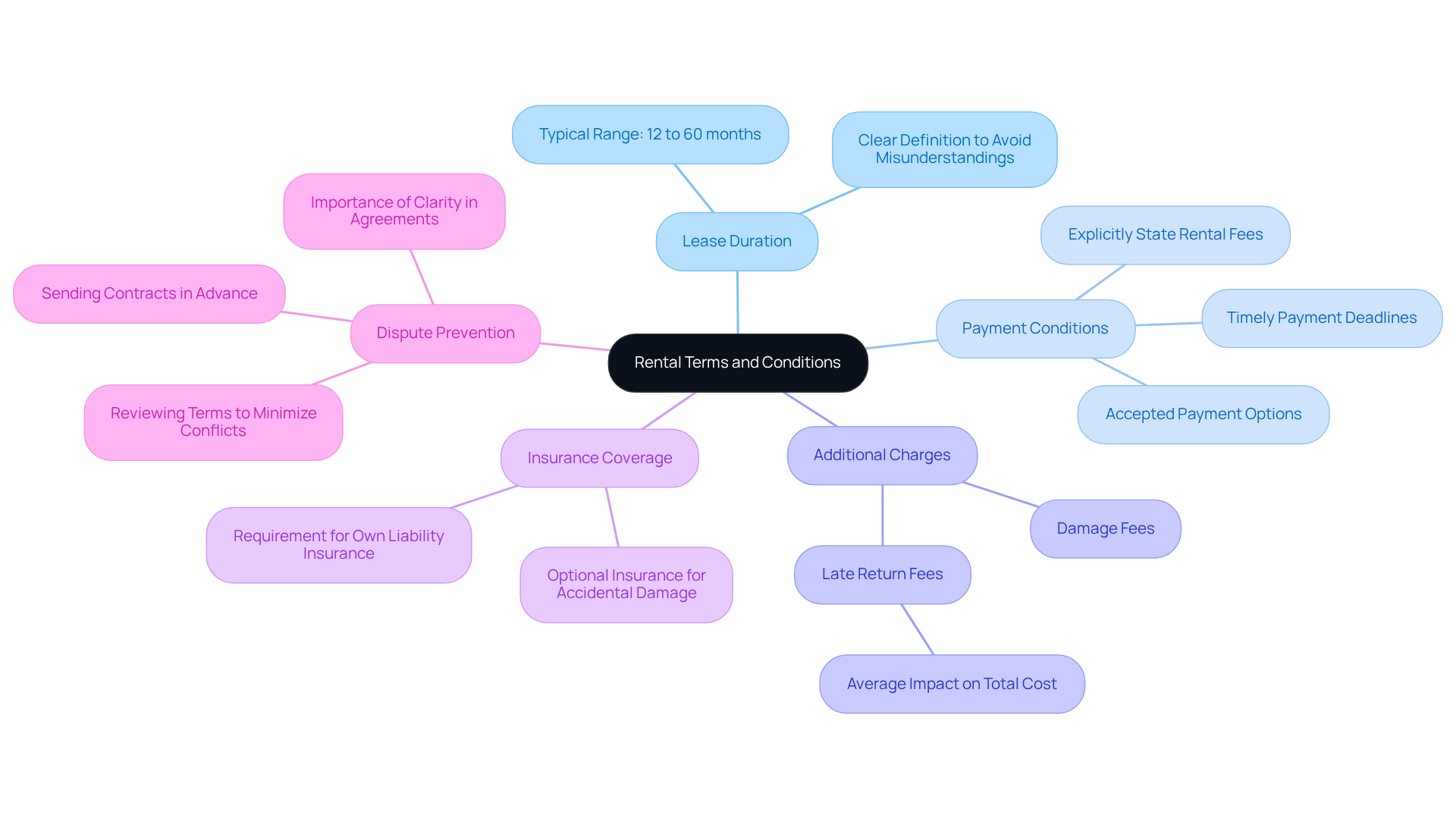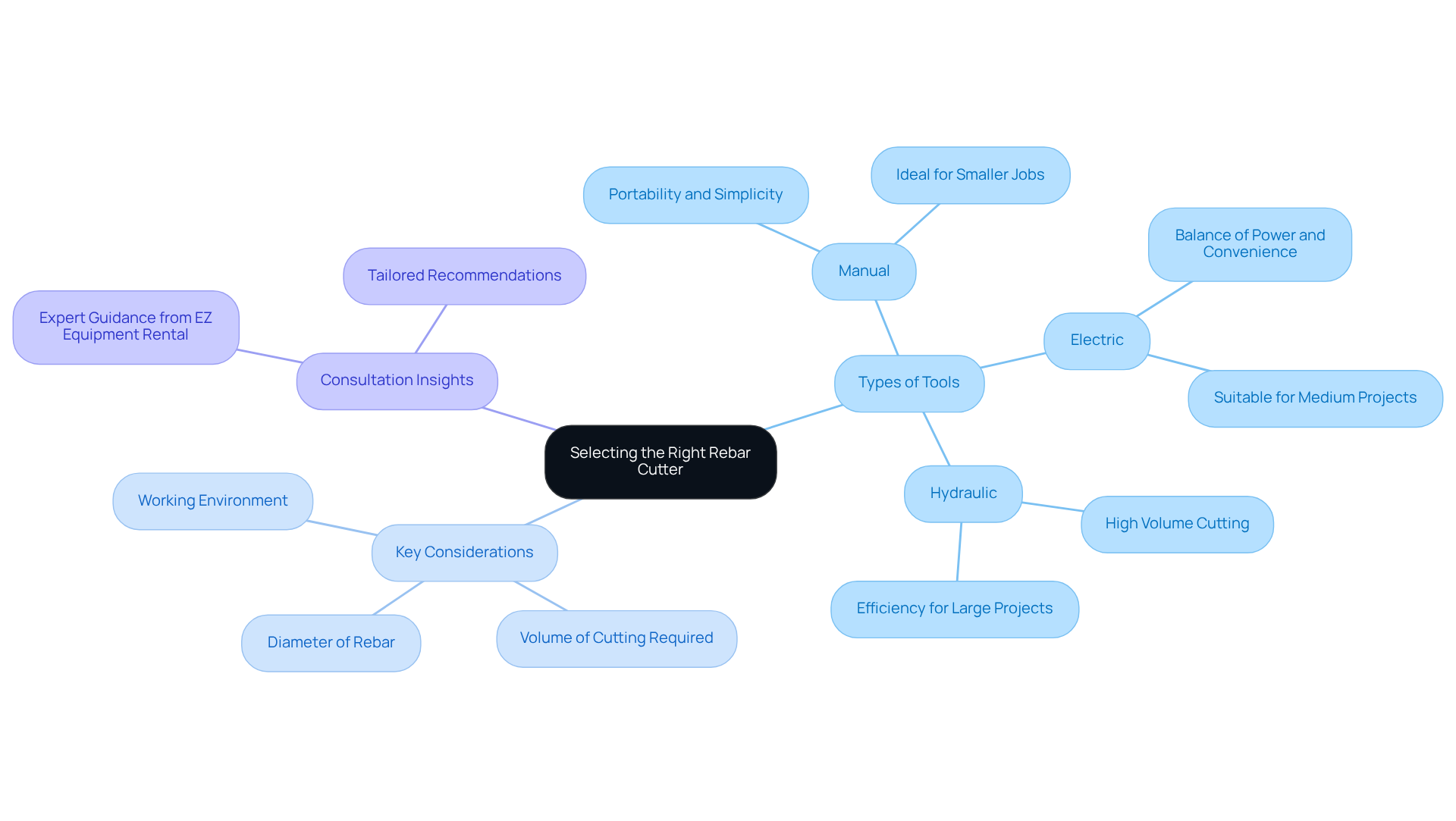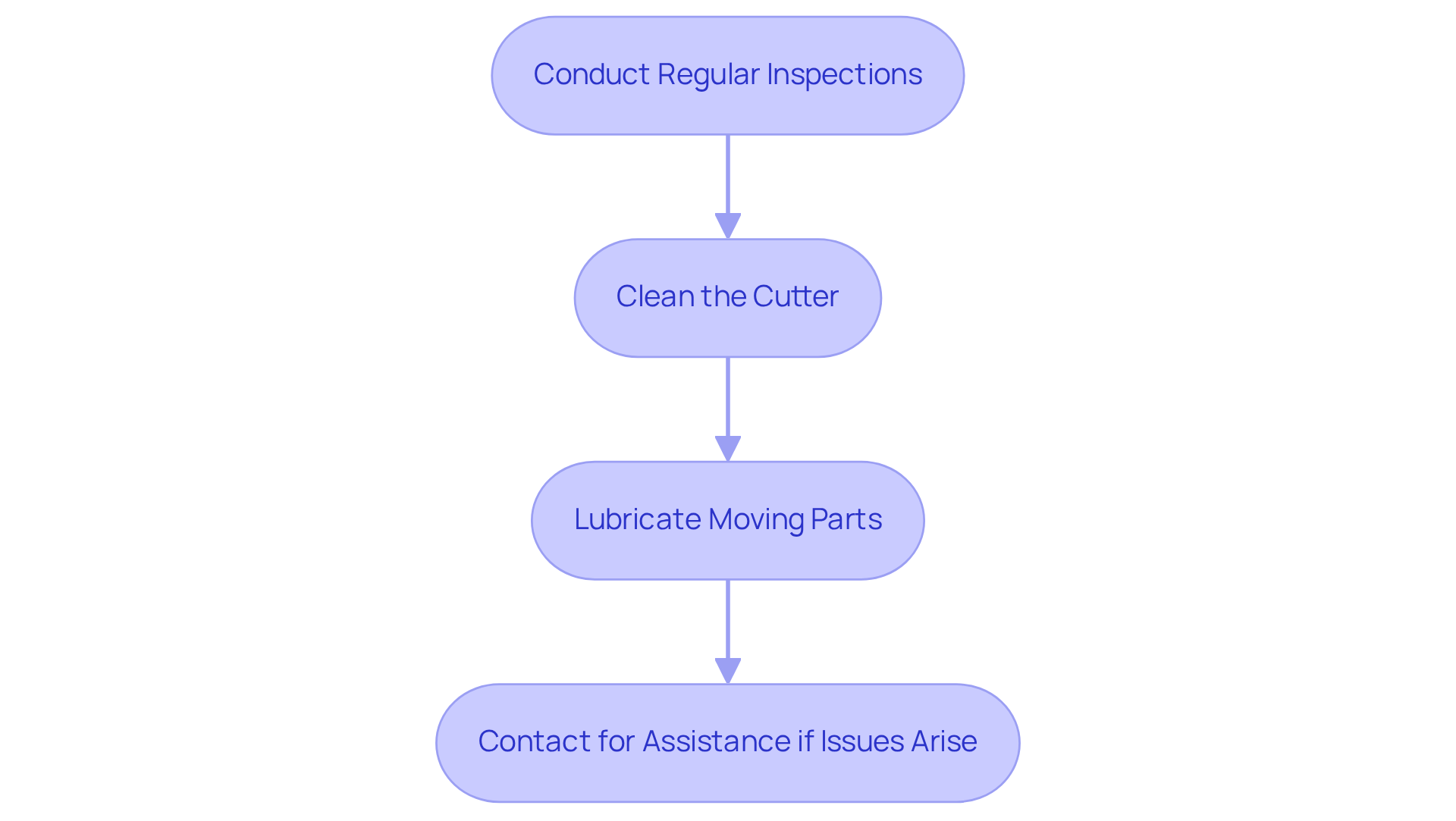Overview
To ensure a successful rebar cutter rental, four essential tips must be followed:
- Carefully reviewing rental terms
- Selecting the appropriate cutter type
- Implementing safety practices
- Maintaining the equipment properly
Understanding lease agreements is crucial to avoid disputes, as it sets clear expectations between the renter and the rental company. Furthermore, choosing the right tool tailored to specific project needs enhances efficiency and effectiveness, making it vital to assess the options available. Safety protocols should be prioritized to prevent accidents, as adherence to these practices not only protects the user but also ensures a smooth workflow. Lastly, conducting regular maintenance is imperative to guarantee functionality and prevent additional charges, reinforcing the importance of proper care for rented equipment.
Key Highlights:
- Review rental terms and conditions carefully to avoid unexpected fees and disputes.
- Clarify lease duration, payment conditions, and insurance coverage before renting.
- Select the right rebar cutter based on project requirements, considering manual, electric, and hydraulic options.
- Safety practises include wearing PPE and conducting pre-operation inspections to prevent accidents.
- Regular maintenance of rented equipment is crucial to ensure functionality and avoid additional charges.
- Statistics show a commitment to safety training among contractors, with 91% focusing on PPE and 75% on power tool safety.
- Understanding the return process and equipment upkeep can enhance the rental experience and mitigate risks.
Introduction
Navigating the world of rebar cutter rentals can be a daunting task, particularly for those unfamiliar with the intricacies of rental agreements and equipment selection. It is essential to understand the terms and conditions, select the appropriate tool for the job, implement safety measures, and maintain rented equipment—these are crucial steps that significantly impact project success. Many renters, however, often overlook these vital aspects, leading to unforeseen challenges and potential costs.
What strategies can be employed to ensure a smooth and efficient rebar cutter rental experience? This article delves into four essential tips designed to empower readers to make informed decisions and maximize their rental experience.
Understand Rental Terms and Conditions
Before opting for a rebar cutter rental, it is essential to thoroughly examine the terms and conditions provided by EZ Equipment Rental. This includes understanding the lease duration, payment conditions, and any additional charges that may apply for late returns or damages. On average, late return fees can significantly impact the total leasing cost, making it crucial to clarify these charges upfront. Customers should also inquire about the insurance coverage offered and whether they need to provide their own, as many leasing companies offer optional insurance to cover accidental damage or theft.
Acquainting oneself with these details can help prevent unexpected expenses and ensure adherence to leasing policies. Industry specialists emphasize that clarity in lease agreements fosters trust and minimizes conflicts. B. Heath Witzen notes, "Clarity in the terms and conditions of machinery lease agreements is essential for building trust between parties." Furthermore, knowing that nearly 30% of leasing contracts result in disputes over damages highlights the importance of reviewing all terms carefully. Understanding the return procedure and any necessary upkeep before sending back the rebar cutter rental can save time and effort, ensuring a seamless borrowing experience. By taking these proactive steps, customers can safeguard themselves from unforeseen legal and financial exposure.
Additionally, the ESIGN Act affirms that electronic contracts hold the same legal significance as paper agreements, a factor that is increasingly relevant in today's digital leasing environment. A practical approach, as illustrated in a case study on enhancing customer understanding of rental agreements, is to send rental contracts in advance. This allows customers to review the terms thoroughly, thereby reducing the likelihood of disputes.

Select the Right Type of Rebar Cutter
Selecting the right rebar tool is crucial for the success of your project. EZ Equipment Rental offers a comprehensive range of rebar cutter rental tools, including manual, electric, and hydraulic options, each tailored for specific applications.
- Manual tools are ideal for smaller jobs due to their portability and simplicity, making them a practical choice for quick tasks.
- In contrast, electric and hydraulic tools are engineered for larger projects that demand greater power and efficiency, enabling faster and more precise cuts.
When choosing a cutting tool, it is essential to consider key factors such as:
- The diameter of the rebar
- The volume of cutting required
- The specific working environment
For example, hydraulic tools excel in high-volume scenarios, while electric models strike a balance between power and convenience. Consulting with the knowledgeable team at EZ Equipment Rental can provide invaluable insights tailored to your project's needs, ensuring you select the most effective tool for the job, including a rebar cutter rental, while maintaining structural integrity. Don't hesitate to reach out and discover how we can assist you in making the best choice for your project.

Implement Safety Practices for Rebar Cutting
Safety is paramount when operating a rebar cutter. Operators must wear suitable personal protective gear (PPE), which includes gloves, goggles, and steel-toed boots. Statistics reveal that:
- 91% of contractors currently implement training programs focused on PPE.
- 75% have training programs on power tool safety.
This underscores the industry's commitment to preventing injuries. Before initiating the cutting process, ensure the work area is free of obstacles and that all personnel maintain a safe distance. Familiarizing yourself with the device's operating manual and adhering to manufacturer guidelines is crucial for safe operation.
Conducting a pre-operation inspection of the cutter can help identify potential issues that may lead to accidents. Furthermore, training sessions on secure equipment handling significantly enhance awareness among team members, fostering a culture of protection that is essential in the construction sector, where nearly 1 in 5 workplace fatalities occur. As Jonny Finity notes, "It is increasingly important to foster an environment of security and minimize the risk of workplace accidents." By prioritizing these protective practices, construction teams can mitigate risks associated with rebar cutter rental and ensure a more secure work environment.
Moreover, the economic expense of injuries in Canada is estimated at $29.4 billion, emphasizing the financial consequences of overlooking protective measures. The involvement of Joint Occupational Health and Safety (JOHS) Committees can further enhance workplace safety by identifying and addressing hazards. By prioritizing these protective practices, construction teams can mitigate risks associated with rebar cutter rental and ensure a more secure work environment.

Maintain and Care for Rented Equipment
Proper upkeep of a leased rebar device is essential during the leasing period to guarantee optimal functionality and prevent extra fees for damages. Conduct regular inspections for signs of wear or damage; neglecting this can lead to costly repairs. After each use, clean the cutter thoroughly to prevent rust and debris buildup, which can impair functionality. Lubricate all moving parts according to the manufacturer's specifications to maintain smooth operation.
As MacAllister Machinery states, "Preventive maintenance can reduce machinery repair bills by 25 percent," underscoring the importance of diligent care. Statistics indicate that device damage rates during rental periods can be significant, emphasizing the need for careful attention. If any issues arise, promptly contact EZ Equipment Rental for assistance.
Following these best practices not only prolongs the life of the equipment but also enhances safety and efficiency on the job site.

Conclusion
Understanding the intricacies of rebar cutter rental is essential for anyone seeking to ensure a successful project. By examining rental terms and conditions, selecting the appropriate type of cutter, implementing safety practices, and maintaining the equipment properly, renters can navigate the process with confidence and efficiency. Each of these elements plays a crucial role in protecting investments and fostering a safer, more productive work environment.
Key insights outlined in this article emphasize the importance of:
- Clarity in rental agreements
- Selecting the right tool based on project requirements
- Adhering to safety protocols
Furthermore, regular maintenance of rented equipment can significantly reduce costs while enhancing overall performance. With these best practices in mind, users can avoid common pitfalls associated with rebar cutter rentals, ensuring a smoother experience.
Ultimately, the significance of these practices extends beyond individual projects; they contribute to a culture of responsibility and safety within the construction industry. By prioritizing knowledge and diligence in rebar cutter rental, stakeholders can protect their investments and promote a safer workplace for all. Whether you are a seasoned contractor or a DIY enthusiast, these tips serve as a valuable guide to achieving success in your next rebar cutting endeavor.
Frequently Asked Questions
What should I understand before renting a rebar cutter?
It is essential to thoroughly examine the rental terms and conditions provided by EZ Equipment Rental, including lease duration, payment conditions, and any additional charges for late returns or damages.
Why is it important to clarify late return fees?
Late return fees can significantly impact the total leasing cost, making it crucial to clarify these charges upfront to prevent unexpected expenses.
What should I inquire about regarding insurance when renting?
Customers should inquire about the insurance coverage offered by the rental company and whether they need to provide their own, as many companies provide optional insurance for accidental damage or theft.
How can understanding rental terms help avoid disputes?
Clarity in lease agreements fosters trust and minimizes conflicts. Nearly 30% of leasing contracts result in disputes over damages, highlighting the importance of reviewing all terms carefully.
What should I know about the return procedure for a rebar cutter rental?
Understanding the return procedure and any necessary upkeep before sending back the rental can save time and effort, ensuring a seamless borrowing experience.
What legal significance do electronic contracts have in rentals?
The ESIGN Act affirms that electronic contracts hold the same legal significance as paper agreements, which is increasingly relevant in today’s digital leasing environment.
How can sending rental contracts in advance help customers?
Sending rental contracts in advance allows customers to review the terms thoroughly, thereby reducing the likelihood of disputes.




